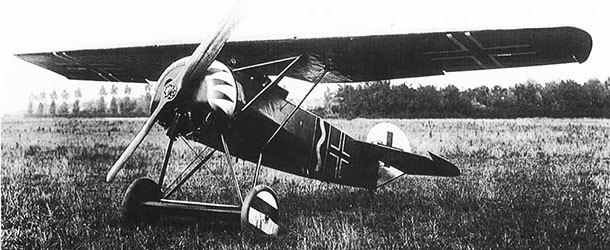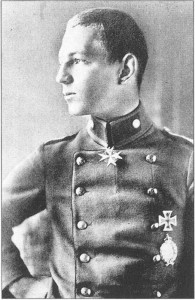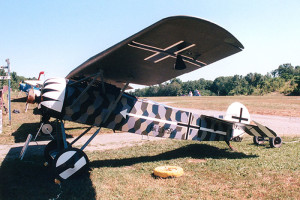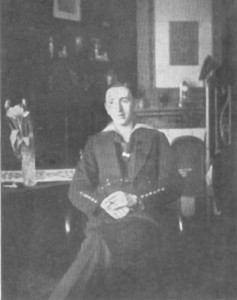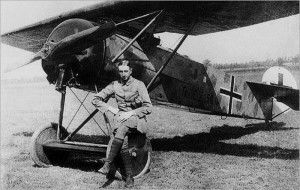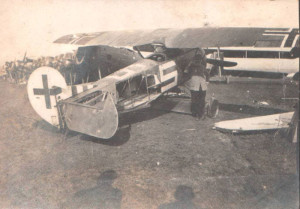Our previous article presented the Fokker E.V, the first aircraft featured in the recently released WW1 Wings of Glory Airplane Packs. Now let’s learn something more about the three versions presented in Wings of Glory.
Erich Löwenhardt
Löwenhardt was born in Breslau, Silesia, of the German Empire on 7 April 1897, the son of a doctor. He received his education at a military school in Lichterfelde. He was 17 when hostilities erupted in August 1914 and was assigned to the German Army's Infantry Regiment Nr. 141; with them he saw infantry action on the Eastern Front.
Young Löwenhardt was wounded near Łódź, but remained on duty as standard bearer for his regiment as it fought in the Battle of Tannenberg. As reward for his courage, on 2 October 1914, he was promoted to Leutnant. On 30 October, he was both wounded and decorated with the Iron Cross Second Class. After convalescence, he returned to his unit in the Carpathians.
In early 1915, he received the Iron Cross 1st Class for gallantry and leadership, saving the lives of five wounded men. Löwenhardt then, by June 1915, was transferred to the Austro-German Alpine Corps for service on the Italian Front. However, he fell ill and was invalided from military service as unfit for duty.
Undeterred, he recuperated for five months and passed the physical exam to join the Imperial Air Service, qualifying as an aerial observer. He then completed pilot training in 1916. In January 1917, he underwent conversion training for fighters and joined a fighter squadron, Jagdstaffel 10, in March 1917. On 24 March 1917, Löwenhardt scored his first confirmed aerial victory, destroying an enemy observation balloon over Recicourt.
Löwenhardt was an aggressive, methodical, skilled fighter whose score grew steadily. During this period, he flew Albatros and Pfalz airplanes. By the end of September, he was an ace. He survived a forced landing on 20 September with a minor wound; the next day, he shot down his fifth victim. He posted two more claims in October, one of which was confirmed.
On 6 November, his aircraft's lower wing was damaged during combat over Winkel Saint Eloi, when an anti-aircraft shell smashed his left wingtip without exploding. He exited the wreckage shaken, but otherwise unharmed. On 30 November 1917, he closed out his year with his eighth confirmed victory.
After adding seven new “victims,” on 1 April Löwenhardt was appointed to command Jasta 10. Löwenhardt's Jasta 10 never converted to Fokker Dr.I triplanes; as the only Staffel of JG I still flying the obsolete Albatros biplanes, it was the ideal unit to receive the first Fokker D.VII biplanes in early May 1918.
Löwenhardt continued to score. On 10 May, he destroyed an observation balloon for his 20th victory and became eligible for the Pour le Merite. The next day, he was awarded the Knight's Cross with Swords of the House Order of Hohenzollern; he also received the Austro-Hungarian Empire's Military Merit Cross. The Pour le Merite (commonly called the Blue Max) came on 31 May 1918, when Löwenhardt's tally had reached 24 (including a DH4, a Camel, and another balloon).
At this point, Löwenhardt was locked in an "ace race" with Ernst Udet and Lothar von Richthofen for the honor of being the top scoring ace in their fighter wing. The rivalry between Löwenhardt and the younger Richthofen was a friendly one, as they often flew as wingmen. He and Lothar von Richthofen often flew together; the long war had decimated the Geschwader's ranks of skilled pilots and the few veteran fliers had to rely on each other.
By the end of July 1918, Löwenhardt's total was 48: 9 balloons and 39 airplanes. On August 8th, he claimed five Allied planes, among them his 50th aerial victory, a milestone (among WWI German pilots) only he, Manfred von Richthofen, and Ernst Udet would achieve.
On 8 August, Allied Forces launched the war's final offensive against the Germans. The British Royal Air Force led the assault, and Löwenhardt downed three of their airplanes. On the 9th, he shot down two more. On August 10, Löwenhardt, flying with a badly swollen sprained ankle, took off about 11 AM, leading a dozen planes from Jastas 10 and 11, including many neophytes. They spotted a flight of British aircraft over Chaulnes a little after noon; when one of the British planes strayed, Löwenhardt quickly nosed down to attack the isolated scout. Several of the new pilots unnecessarily followed in his wake. Ltn. Alfred Wentz of Jasta 11 and Löwenhardt collided.
As Wentz described it, Löwenhardt's wheels struck his upper right wing. His airplane out of control, Wentz hit the silk and landed safely. Löwenhardt also took to his parachute, but it didn't open and the fall killed the great ace, who died with 54 aerial victories to his credit.
Theodor Osterkamp
Theodor "Theo" Osterkamp, born in April 1892, was a World War I and World War II Luftwaffe fighter ace. He flew in the First World War, scoring 32 victories. In World War II he led Jagdgeschwader 51 through the Battle of Britain and claimed a further 6 victories. He became one of the few men to score victories in both World Wars.
Osterkamp flew as a naval pilot operating over the Western Front. On 14 August 1914, he joined the Marinefliegerkorps and flew with the 2. Marine-Fliegerabteilung in Flanders. During 1915–1916, he served as an air observer, and became the first German pilot to fly a land-based aircraft into England on a reconnaissance-mission.
On 1915, Osterkamp was sent to the II. Marine-Landflieger-Abteilung at Moorsele: the unit was equipped with Albatros B.I biplanes. These dedicated observation planes, had no defense weapons; Osterkamp complained about this and asked for machine guns. He was not immediately heard. In the meantime, he assured the plane's defense with a semi-automatic Mauser rifle. On September 7th, 1915, Theo was promoted Vizefeuerwerker and received the Iron Cross 2nd class.
He was known as being an excellent observer. For example, he found the 4th army HQ during a mission above Dunkirk and Boulogne. On May 26th, 1916, Osterkamp and Mattheus received the mission to bomb the Monitor, a warship of the Royal Navy, "by hand." Osterkamp had 4 bombs of 10 kg each. The first one resulted in a strong explosion on the rear part of the ship. Then, they flew back, taking shots from the Monitor.
In March, 1917, Osterkamp attended the fighting class at Johannisthal to become a pilot: he obtained his license within 8 days, and joined the Kampffliegerschule in Putzig and then joined the Marine-Jagdstaffel 1.
He flew Fokker E.II, E.IV and then D.II at the Fokker Schule in Putzig. On April 13th, 1917, he was sent to the 1st navy fighter squadron (I. Marine-Feld-Jagdstaffel) in Belgium at Aartrijke to fly an Albatros. On April 30th, during a landing, he broke the landing gear of an Albatros D.III and was suspended two weeks. He endured this suspension and shot down a Sopwith near Dixmude, his first official victory.
On June 1917, Mattheus joined him and their unit was re-equipped with the Albatros DV. Theo painted a Maltese cross and two black strips on his Albatros D.V D.2130/17, which then looked like a wasp. Osterkamp, who became Leutnant, used this plane to shoot down another Sopwith on July 11th and a SE.5 of 56 Sqn on the 12th; he then became an ace with 5 victories.
His friend Mattheus was seriously injured on December 28th, 1917 and he died two weeks late. Osterkamp barely recovered from it. He found success again on March 26th, 1918 shooting down a Camel. He added two other Camels on March 26th and April 23rd, with his 10th victory on April 25th against a Spad.
On April 27th, Osterkamp received Crosses Frédéric Auguste d'Oldenburg 1st and 2nd classes. On June 1st, he was named Knight of the Albert Order. On May 11th, he shot down a Camel (B7192) of 213 Sqn. Then he added 5 other victories in June aboard a Fokker D VII. His score was then 16 victories. On August 12th, 1918, Osterkamp obtained his 20th victory during a mission led by Sachsenberg.
In August, the Leutnant zur See Osterkamp obtained 4 new victories for a total of 23. He was shot down by three Spads while testing a Fokker E.V, but parachuted to safety. On September 2nd, 1918, he received the War Merit Cross.
From September 17th until November 11th, he shot down 7 planes, including a double victory on September 28th. He also "shot down" a tank, which he claimed as his 29th victory. He ended the war with 32 victories plus 6 probable, and was awarded the Prussian military order Pour le Mérite on 2 September 1918, the last individual to receive it.
Between the two World Wars, Osterkamp was involved in the formation of the new Luftwaffe. On 19 September 1939 Oberst Osterkamp was appointed Geschwaderkommodore of Jagdgeschwader 51. During the Battle of France he claimed four victories, and during the Kanalkampf period of the Battle of Britain in July 1940, he claimed a further two victories, bringing his total to six. He then served in a number of Staff positions until he was dismissed from the service on 21 December 1944.
Karl Sharon
Vizeflugmeister Karl Sharon was a World War I flying ace credited with eight aerial victories.
Karl Sharon was born on 15 May 1892, and first came to notice when flying a Fokker D.VII for Marine Feld Jagdstaffel 2. The German naval fighter squadron was based at Jabbeke, Belgium. Sharon was promoted to Vizefeldmeister on 16 August 1918.
Sharon scored his first aerial victory on 20 September 1918, when he shot down a Sopwith Camel from No. 204 RAF Squadron over Pervyse. On 7 October, he downed another Camel south of Blankenberghe, Belgium along with an Airco DH.9.
He then destroyed a third Camel on 14 October over Roeselare, and a Sopwith Dolphin the following day, running his total to five. He was credited with an "enemy aircraft" for his next victory, date and location uncertain. Then, he shot down a Camel from 204 Squadron on both 23 and 27 October 1918, running his tally to eight.
Sharon survived the war, having been awarded the Iron Cross First Class, and participated in the postwar fighting by joining the Marine Freikorps in Latvia and other Baltic nations. He perished on 26 May 1921.
Information sources: Ace Pilots, Wikipedia, Passion Aviation, Skytamer.com, Theory of Aces, Cody Swartz's (FokkerDVII) Bucket, Luchtoverwinningen Theo Osterkamp.

